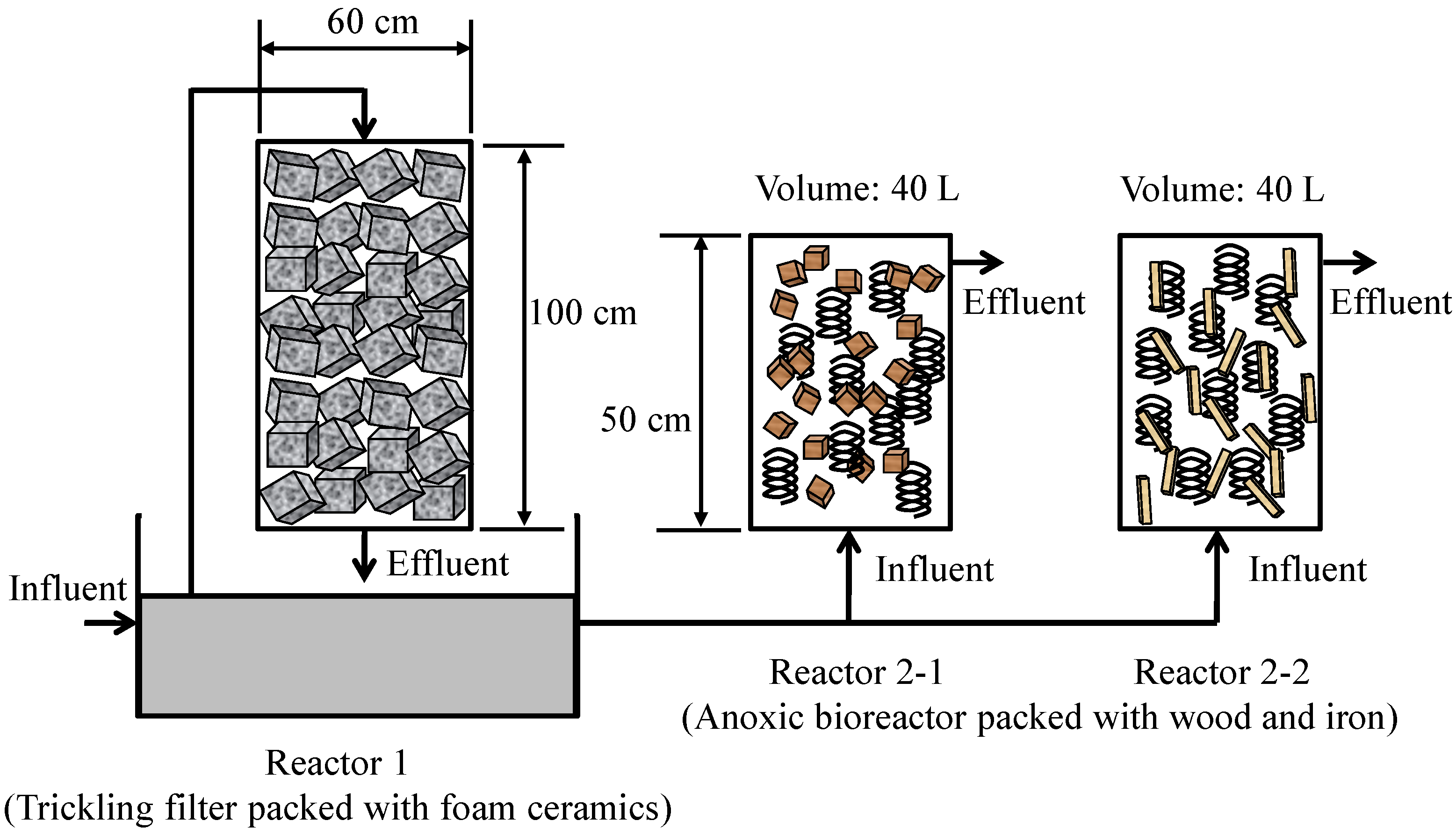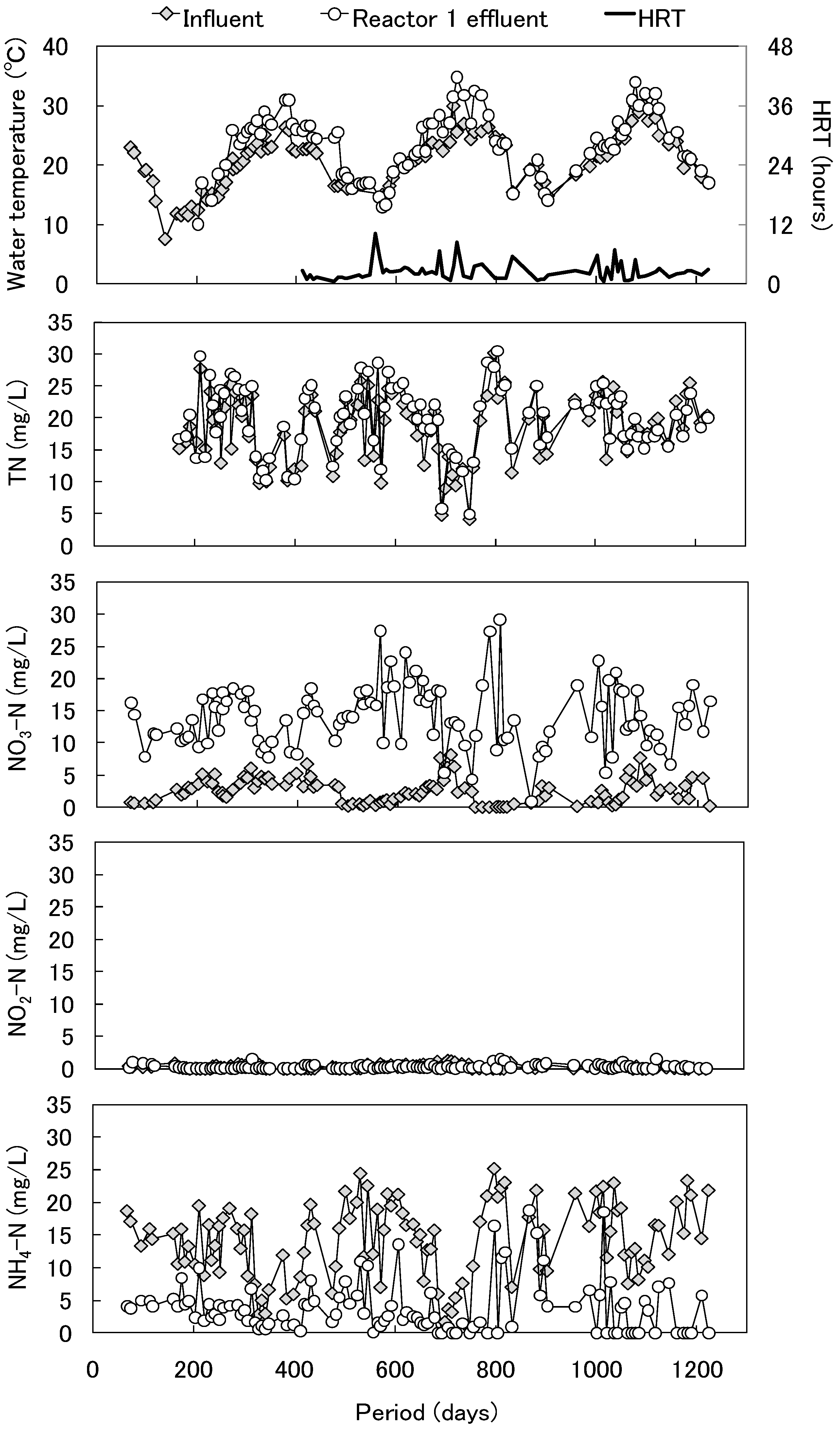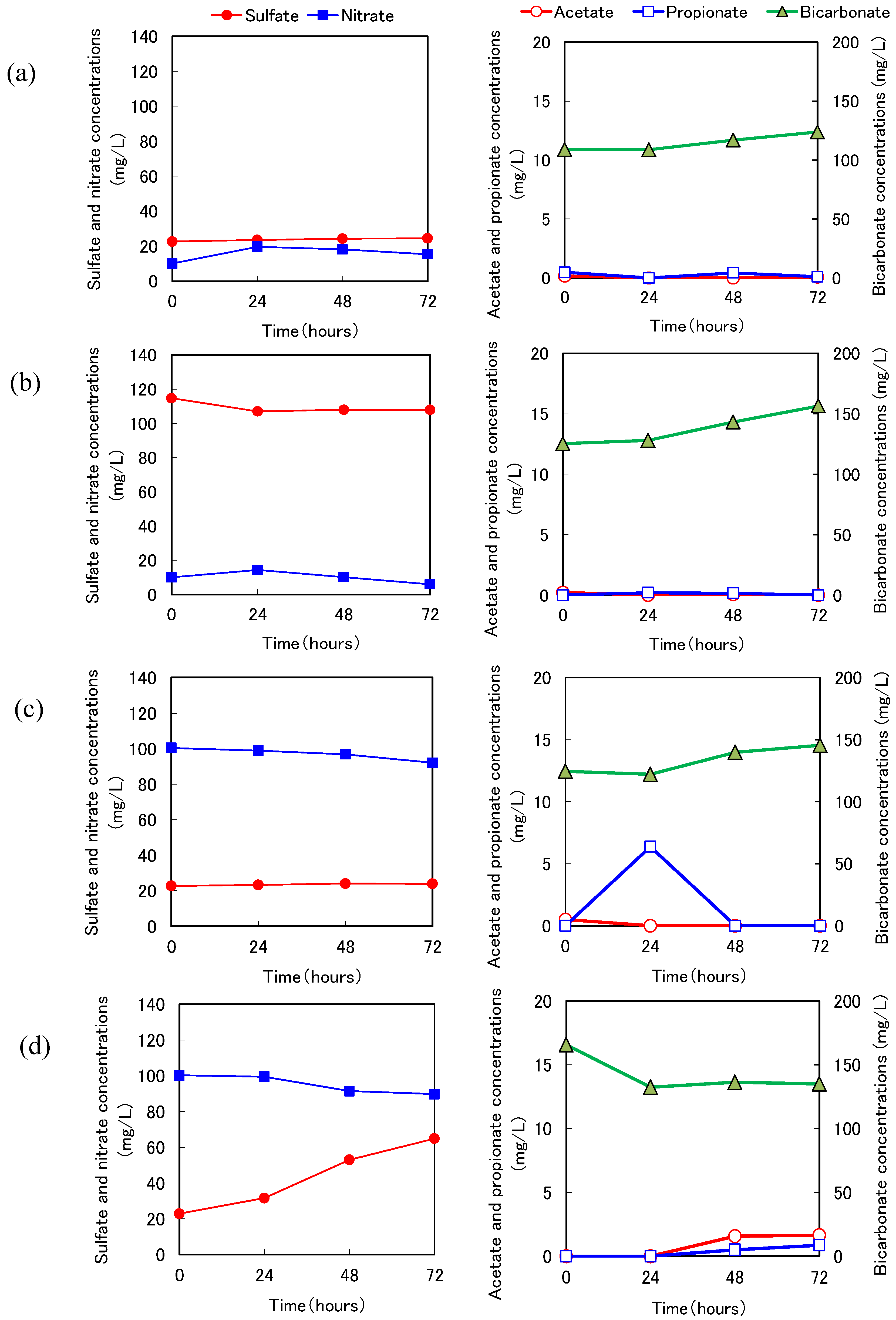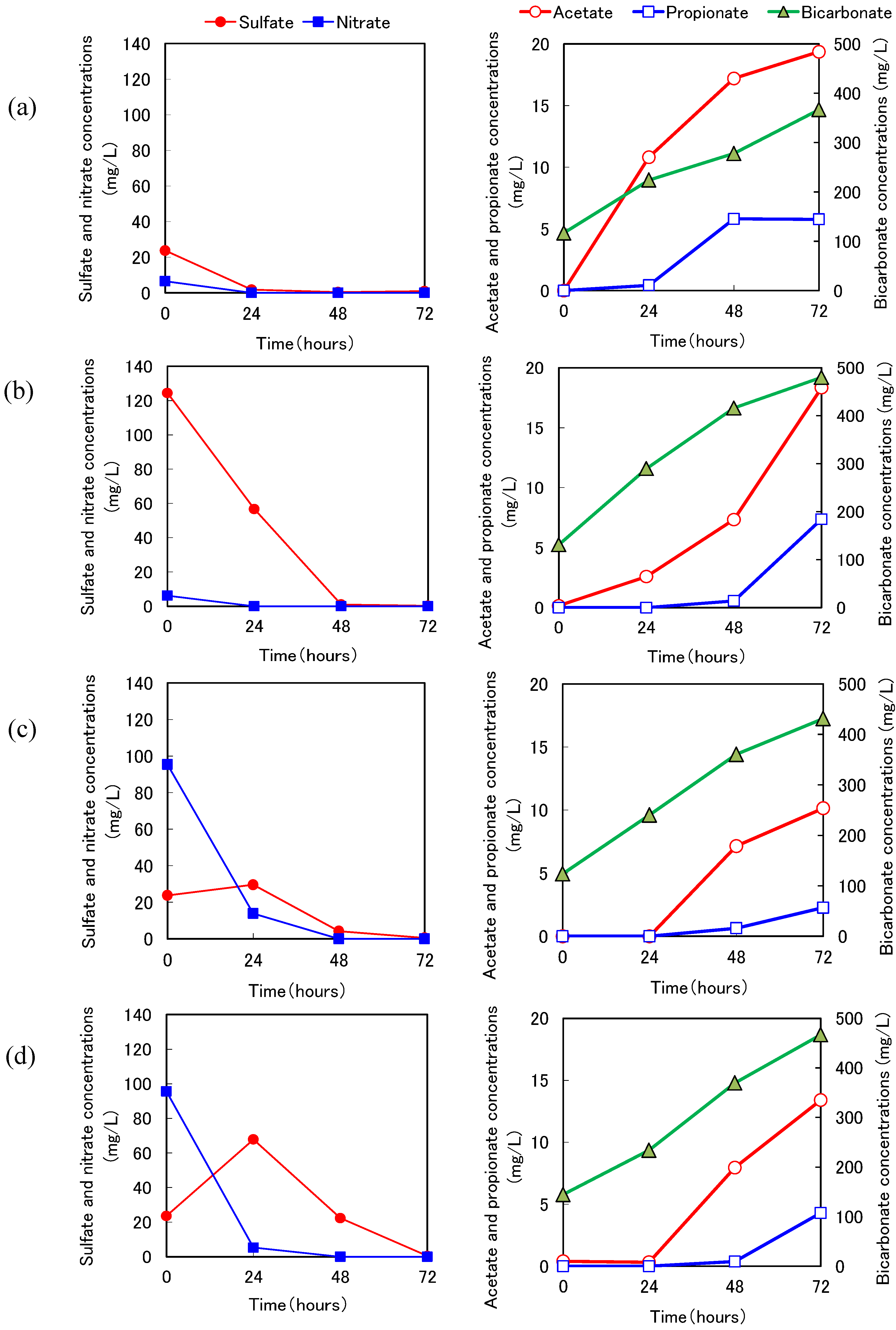Nitrogen and Phosphorus Removal from Wastewater Treatment Plant Effluent via Bacterial Sulfate Reduction in an Anoxic Bioreactor Packed with Wood and Iron
Abstract
:1. Introduction
2. Materials and Methods
2.1. Reactor and Experimental Procedure

| Operational Period (Days) | HRT (Hours) |
|---|---|
| 0–150 | 24 |
| 151–259 | 18 |
| 260–343 | 12 |
| 344–440 | 6 |
| 441–557 | 12 |
| 558–1224 | 24 |
2.2. Batch Experiments to Analyze the Sulfate Reduction and Denitrification Activities with the Use of Wood in Reactors 2-1 and 2-2
| Exp. no. | B1 | B2 | S1 | S2 |
|---|---|---|---|---|
| Wood in the reactor (g-wet weight/90mL) | ||||
| Cedar | 25 | - | 25 | - |
| Aspen | - | 25 | - | 25 |
| The added substrates (mg/L) | ||||
| K2SO4 | - | - | 181 | 181 |
| NaNO3 | - | - | - | - |
| Na2S2O3∙5H2O | - | - | - | - |
| Exp. no. | N1 | N2 | TN1 | TN2 |
| Wood in the reactor(g-wet weight/90mL) | ||||
| Cedar | 25 | - | 25 | - |
| Aspen | - | 25 | - | 25 |
| The added substrates (mg/L) | ||||
| K2SO4 | - | - | - | - |
| NaNO3 | 137 | 137 | 137 | 137 |
| Na2S2O3∙5H2O | - | - | 250 | 250 |
2.3. Analytical Methods
2.4. Dissimilatory (bi)sulfite Reductase Gene-Targeted Nested PCR-DGGE Analysis

3. Results and Discussion
3.1. Nitrification Performance of the Trickling Filter Packed with foam Ceramics (Reactor 1)


3.2. Nitrogen and Phosphorus Removal in the Anoxic Bioreactor Packed with Wood and Iron (Reactors 2-1 and 2-2)


3.3. Denitrification and Sulfate Reduction Activities in the Batch Experiments (Reactors 2-1 and 2-2)


| Denitrification Rates | Sulfur Denitrification Rates | Sulfate Reduction Rates | ||||
|---|---|---|---|---|---|---|
| (g COD/kg dry weight wood∙day) | (g COD/kg dry weight wood∙day) | (g COD/kg dry weight wood∙day) | ||||
| Elapsed time (day) | Reactor 2-1 * | Reactor 2-2 ** | Reactor 2-1 * | Reactor 2-2 ** | Reactor 2-1 * | Reactor 2-2 ** |
| 593 | 0.03 | 0.92 | 0.12 | 0.44 | 0.02 | 0.82 |
| 784 | 0.08 | 1.21 | 0.04 | 0.91 | 0.04 | 0.53 |
| 1104 | 0.09 | 0.91 | 0.04 | 0.76 | 0.04 | 0.32 |
| 1224 | 0.10 | 0.85 | 0.01 | 0.46 | 0.07 | 0.25 |
3.4. Microbial Communities of Sulfate-Reducing Bacteria Attached to the Wood and Iron Taken from Reactors 2-1 and 2-2
| Reactor No. | Elapsed Time (day) | Band a | FASTA | BLAST | ||||||
|---|---|---|---|---|---|---|---|---|---|---|
| Sequencelength (bp) | Closest Relative | Accession No.b | % Identity c | Overlap (bp) | Closest Relative | Accession No. d | % Identityc | |||
| 2-1 | 426 | 1-1 | 321 | Desulfovibrio vulgaris | AE017285 | 64.0 | 314 | Desulfovibrio vulgaris | AE017285 | 93(31/33) |
| 1-2 | 320 | Desulfobulbus propionicus | AF218452 | 80.6 | 319 | Desulfobulbus propionicus | AF218452 | 84(144/170) | ||
| 749 | 1-3 | 340 | Desulfoarculus baarsii | AF334600 | 76.9 | 325 | Desulfoarculus baarsii | AF334600 | 89(130/145) | |
| 1-4 | 335 | Desulfovibrio fructosovorans | AF418187 | 72.0 | 311 | Desulfovibrio sp. | AF360650 | 90(72/80) | ||
| 1104 | 1-5 | 280 | Desulfoarculus baarsii | AF334600 | 79.1 | 268 | Desulfoarculus baarsii | AF334600 | 89(128/143) | |
| 1-6 | 290 | Desulfovibrio fructosovorans | AF418187 | 75.4 | 264 | Desulfovibrio sp | AF360650 | 92(62/67) | ||
| 1224 | 1-7 | 309 | Desulfotomaculum thermocisternum | AF074396 | 63.1 | 314 | Desulfotomaculum reducens | CP000612 | 100(26/26) | |
| 1-8 | 311 | Desulfotomaculum putei dissimilato | AF273032 | 70.3 | 290 | Desulfotomaculum partial | FM999736 | 94(34/36) | ||
| 1-9 | 316 | Desulfovibrio carbinolicus | AY626026 | 79.8 | 267 | Desulfovibrio carbinolicus | AY626026 | 92(95/103) | ||
| 1-10 | 309 | Desulfovibrio aminophilus | AY626029 | 76.6 | 308 | Desulfovibrio sp. | U58117 | 83(136/162) | ||
| 1-11 | 298 | Desulfovibrio aespoeensis | AF492838 | 65.5 | 258 | Desulfovibrio sp. | AF360650 | 90(37/41) | ||
| 2-2 | 426 | 2-1 | 359 | Desulfobulbus elongatus | AJ310430 | 73.0 | 337 | Desulfobulbus elongatus | AJ310430 | 80(161/200) |
| 2-2 | 349 | Desulfobulbus rhabdoformis | AJ250473 | 86.7 | 330 | Desulfobulbus rhabdoformis | AJ250473 | 90(228/253) | ||
| 2-3 | 363 | Desulfovibrio gigas | U80961 | 72.4 | 348 | Desulfovibrio gigas | U80961 | 82(149/180) | ||
| 749 | 2-4 | 280 | Desulfacinum infernum | AF418194 | 78.1 | 274 | Desulfacinum infernum | AF482454 | 93(73/78) | |
| 2-5 | 287 | Desulfovibrio fructosovorans | AB061538 | 77.0 | 261 | Desulfovibrio sp | AF360650 | 91(75/82) | ||
| 2-6 | 243 | Syntrophobacter fumaroxidans | CP000478 | 81.4 | 242 | Syntrophobacter fumaroxidans | CP000478 | 89(106/119) | ||
| 1104 | 2-7 | 290 | Desulfofustis glycolicus | AF418191 | 82.3 | 282 | Desulfofustis glycolicus | AF482457 | 83(212/253) | |
| 2-8 | 290 | Desulfovibrio aerotolerans | AY749039 | 77.9 | 281 | Desulfovibrio aminophilus | AY626029 | 92(78/84) | ||
| 1224 | 2-9 | 311 | Desulfofustis glycolicus | AF418191 | 73.9 | 264 | Desulfofustis glycolicus | AF482457 | 82(114/139) | |
| 2-10 | 263 | Syntrophobacter fumaroxidans | CP000478 | 73.7 | 255 | Syntrophobacter fumaroxidans | CP000478 | 85(61/71) | ||
| 2-11 | 329 | Desulfovibrio carbinolicus | AY626026 | 69.6 | 313 | Desulfovibrio sp. | AF360650 | 90(63/70) | ||
4. Conclusions
- The average nitrification rate in the trickling filter was 0.17 kg N/m3∙day and stayed at 0.11 kg N/m3∙day even when the water temperature was below 15 °C. The recycle ratio had relatively little effect on the nitrification rate and the nitrification rate did not tend to increase with increasing water temperature.
- The nitrogen and phosphorus removal in the bioreactor packed with cedar chips and iron continued until approximately 500 days of operation, but the removal decreased significantly after that period. In contrast, the nitrogen and phosphorus removal in the bioreactor packed with aspen wood and iron continued over 1200 days of operation. The nitrogen and phosphorus removal performance of the bioreactor packed with aspen wood and iron was higher than that of the bioreactor packed with cedar chips and iron during the operational period.
- The TOC in the bioreactor packed with wood and iron decreased to a mean value of 1 mg/L, and thus it was confirmed that there was no increase in the amount of dissolved organic matter in the outflow from the bioreactors.
- The denitrification rate obtained using the aspen wood taken from Reactor 2-2 at 784 days was the highest of the batch experiments, at 0.42 g NO3-N/kg dry weight wood∙day.
- Compared to the organic compounds in the cedar chips, the organic compounds in the aspen wood were easier for the sulfate-reducing bacteria and denitrifying bacteria to utilize for wood degradation.
- Sulfate-reducing bacteria grew inside the wood in a long-term operation under denitrification conditions, although the microbial communities of sulfate-reducing bacteria in Reactors 2-1 and 2-2 changed during the operation.
Supplementary Files
Supplementary File 1Acknowledgments
Author Contributions
Conflicts of Interest
References
- Campbell, W.A.B. Methaemoglobinaemia due to nitrates in well-water. Br. Med. J. 1952, 2, 371–373. [Google Scholar] [CrossRef]
- Timmermans, P.; van Haute, A. Denitrification with methanol: Fundamental study of the growth and denitrification capacity of Hyphomicrobium sp. Water Res. 1983, 17, 1249–1255. [Google Scholar] [CrossRef]
- Bill, K.A.; Bott, C.B.; Murthy, S.N. Evaluation of alternative electron donors for denitrifying moving bed biofilm reactors (MBBRs). Water Sci. Technol. 2009, 60, 2647–2657. [Google Scholar]
- Yamashita, T.; Yamamoto-Ikemoto, R.; Zhu, J. Sulfate-reducing bacteria in a denitrification reactor packed with wood as a carbon source. Bioresour. Technol. 2011, 102, 2235–2241. [Google Scholar] [CrossRef]
- Liamleam, W.; Annachhatre, A.P. Electron donors for biological sulfate reduction. Biotechnology Adv. 2007, 25, 452–463. [Google Scholar] [CrossRef]
- Chen, M.; Zhang, Y.; Zhou, J.; Dong, X.; Wang, X.; Shi, Z. Sulfate removal by Desulfovibrio sp. CMX in chelate scrubbing solutions for NO removal. Bioresour. Technol. 2013, 143, 455–460. [Google Scholar] [CrossRef]
- Yücel, M.; Galand, P.E.; Fagervold, S.K.; Contreira-Pereira, L.; Bris, N.L. Sulfide production and consumption in degrading wood in the marine environment. Chemosphere 2013, 90, 403–409. [Google Scholar]
- Emerson, S.; Widmer, G. Early diagenesis in anaerobic lake sediments—II. Thermodynamic and kinetic factors controlling the formation of iron phosphate. Geochim. Cosmochim. Acta 1978, 42, 1307–1316. [Google Scholar] [CrossRef]
- Till, B.A.; Weathers, L.J.; Alvarez, P.J.J. Fe(0)-supported autotrophic denitrification. Environ. Sci. Technol. 1998, 32, 634–639. [Google Scholar] [CrossRef]
- Yamashita, T.; Yamamoto-Ikemoto, R. Phosphate removal and sulfate reduction in a denitrification reactor packed with iron and wood as electron donors. Water Sci. Technol. 2008, 58, 1405–1413. [Google Scholar] [CrossRef]
- Miletto, M.; Bodelier, P.L.E.; Laanbroek, H.J. Improved PCR-DGGE for high resolution diversity screening of complex sulfate-reducing prokaryotic communities in soils and sediments. J. Microbiol. Methods 2007, 70, 103–111. [Google Scholar]
- DNA Data Bank of Japan. Available online: http://www.ddbj.nig.ac.jp/ (accessed on 31 March 2013).
- Barnes, D.; Bliss, P.J. Biological Control of Nitrogen in Wastewater Treatment; E. & F.N. Spon: London, UK, 1983; p. 146. [Google Scholar]
- Shin, J.H.; Sang, B.I.; Chung, Y.C.; Choung, Y.K. A novel CSTR-type of hollow fiber membrane biofilm reactor for consecutive nitrification and denitrification. Desalination 2008, 221, 526–533. [Google Scholar]
- Tsuneda, S.; Nagano, T.; Hoshino, T.; Ejiri, Y.; Noda, N.; Hirata, A. Characterization of nitrifying granules produced in an aerobic upflow fluidized bed reactor. Water Res. 2003, 37, 4965–4973. [Google Scholar]
- Seo, J.-K.; Jung, I.-H.; Kim, M.-R.; Jin Kim, B.; Nam, S.-W.; Kim, S.-K. Nitrification performance of nitrifiers immobilized in PVA (polyvinyl alcohol) for a marine recirculating aquarium system. Aquacult. Eng. 2001, 24, 181–194. [Google Scholar] [CrossRef]
- Parker, D.S.; Jacobs, T.; Bower, E.; Stowe, D.W.; Farmer, G. Maximizing trickling filter nitrification rates through biofilm control: Research review and full scale application. Water Sci. Technol. 1997, 36, 255–262. [Google Scholar]
- Speijers, G.J.A. Guidelines for Drinking-Water Quality; World Health Organization: Geneva, Switzerland, 1996; Volume 2. [Google Scholar]
- Greenan, C.M.; Moorman, T.B.; Kaspar, T.C.; Parkin, T.B.; Jaynes, D.B. Comparing carbon substrates for denitrification of subsurface drainage water. J. Environ. Qual. 2006, 35, 824–829. [Google Scholar]
- Geets, J.; Borremans, B.; Diels, L.; Springael, D.; Vangronsveld, J.; van der Lelie, D.; Vanbroekhoven, K. DsrB gene-based DGGE for community and diversity surveys of sulfate-reducing bacteria. J. Microbiol. Methods 2006, 66, 194–205. [Google Scholar]
- Widdel, F.; Pfennig, N. Studies on dissimilatory sulfate-reducing bacteria that decompose fatty acids II. Incomplete oxidation of propionate by Desulfobulbus propionicus gen. nov., sp. nov. Arch. Microbiol. 1982, 131, 360–365. [Google Scholar]
- Garrity, G.M.; Brenner, D.J.; Krieg, N.R.; Staley, J.R. Bergey’s Manual of Systematic Bacteriology, Part C, 2nd ed.; Springer: New York, NY, USA, 2005; Volume 2. [Google Scholar]
- Tao, X.Y.; Li, Y.B.; Huang, H.Y.; Chen, Y.; Liu, P.; Li, X.K. Desulfovibrio vulgaris Hildenborough prefers lactate over hydrogen as electron donor. Ann. Microbiol. 2014, 64, 451–457. [Google Scholar] [CrossRef]
- Rees, G.N.; Grassia, G.S.; Sheehy, A.J.; Dwivedi, P.P.; Patel, B.K.C. Desulfacinum infernum gen. nov., sp. nov., a thermophilic sulfate-reducing bacterium from a petroleum reservoir. Int. J. Syst. Bacteriol. 1995, 45, 85–89. [Google Scholar] [CrossRef]
- Boone, D.R.; Bryant, M.P. Propionate-degrading bacterium, Syntrophobacter wolinii sp. nov. gen. nov., from methanogenic ecosystems. Appl. Environ. Microbiol. 1980, 40, 626–632. [Google Scholar]
- Friedrich, M.; Springer, N.; Ludwig, W.; Schink, B. Phylogenetic positions of Desulfofustis glycolicus gen nov, sp nov, and Syntrophobotulus glycolicus gen nov, sp nov, two new strict anaerobes growing with glycolic acid. Int. J. Syst. Bacteriol. 1996, 46, 1065–1069. [Google Scholar] [CrossRef]
© 2014 by the authors; licensee MDPI, Basel, Switzerland. This article is an open access article distributed under the terms and conditions of the Creative Commons Attribution license (http://creativecommons.org/licenses/by/3.0/).
Share and Cite
Yamashita, T.; Yamamoto-Ikemoto, R. Nitrogen and Phosphorus Removal from Wastewater Treatment Plant Effluent via Bacterial Sulfate Reduction in an Anoxic Bioreactor Packed with Wood and Iron. Int. J. Environ. Res. Public Health 2014, 11, 9835-9853. https://doi.org/10.3390/ijerph110909835
Yamashita T, Yamamoto-Ikemoto R. Nitrogen and Phosphorus Removal from Wastewater Treatment Plant Effluent via Bacterial Sulfate Reduction in an Anoxic Bioreactor Packed with Wood and Iron. International Journal of Environmental Research and Public Health. 2014; 11(9):9835-9853. https://doi.org/10.3390/ijerph110909835
Chicago/Turabian StyleYamashita, Takahiro, and Ryoko Yamamoto-Ikemoto. 2014. "Nitrogen and Phosphorus Removal from Wastewater Treatment Plant Effluent via Bacterial Sulfate Reduction in an Anoxic Bioreactor Packed with Wood and Iron" International Journal of Environmental Research and Public Health 11, no. 9: 9835-9853. https://doi.org/10.3390/ijerph110909835




